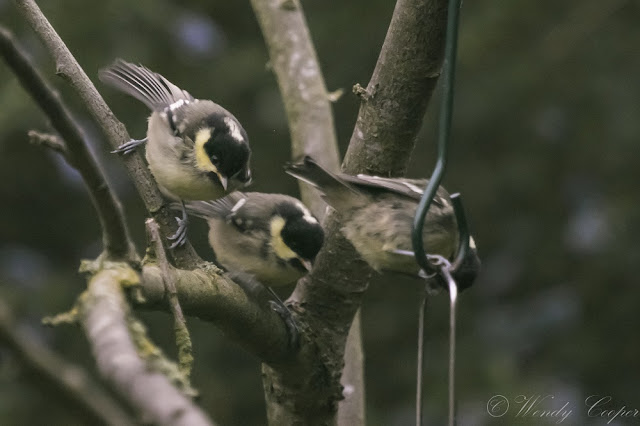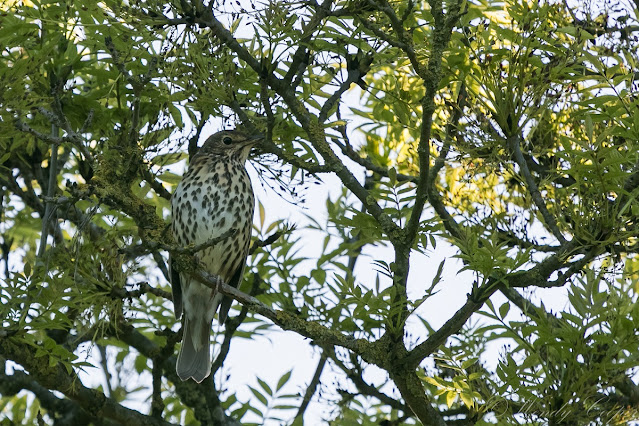Summer Happenings on My Local Patch
My
goodness, where has summer gone?
From
the end of May, with gently warm days, in a matter of weeks summer became a
furnace – I’m not complaining mind you, but it did leave me wondering how our
wildlife would fare, but from what I have seen on my Local Patch, feathered
friends at least have managed well. Over the past few weeks, summer has
become a little more gentle and the rains have returned, everything is green
again.
That
the birds had been busy during a changeable spring was reinforced at the end of
May, when my garden was suddenly full of parents trying to feed numbers of
noisy and demanding fledglings. The first to appear were a troupe of Coal
Tits, who, whilst waiting assistance from Mum and Dad, were also trying to
figure out the feeding stations for themselves. I also got to watch the
parents teaching the youngsters how to manage their food – hold it in your
claws and peck away morsels, don’t attempt down in one!
Within a week or so, they were all regularly returning and helping themselves to seeds, sunflower hearts and chopped peanuts and as they matured over the following weeks, I gradually watched their colours change. Around the same time, Blue Tit fledglings began to arrive, parents in tow, who were kept very busy providing feeding lessons and silver service to the demanding youngsters.
These always provide an element of comedy, as the youngsters get themselves into a bit of a tantrum whilst calling for food!
We have also had the pleasure of watching the pigeons raise two broods in our garden, the first time round we had two youngsters exploring before they fledged properly and this weekend, one youngster was exploring the feeders and garden in somewhat damp weather!
A
first for us in the back garden this year has also been watching busy
Blackbirds too-ing and fro-ing from a nest with big beaks of food. When the
time was right, we finally ‘met’ two Blackbird youngsters – we were impressed,
however our cats were not, being kept under house arrest for a few days until
we were happy that the little ones had safely left the confines of the garden
and found their wings. We also have had Blackbirds nest successfully for
a second year in our front garden.
Further afield on my usual route I first heard and then found a Great Spotted Woodpecker nest. I think the youngsters were quite well grown, judging by how vocal they were, however only one parent (the male) was feeding them. I know the local Sparrowhawk had been quite active, so I am wondering if that was the female’s demise. The remaining bird looked as though he had been working hard and was certainly not looking his best, with rather grubby feathers (he confused my neighbour as to what he was due to his colouring!) I did return a few times after first seeing them, however I am not sure if the youngsters made it to fledging, although I have been hearing Great Spotted Woodpeckers calling in the woods, so just maybe!
Through June, from various vantage points, there seemed to be a great number of Song Thrushes in full song this year and whilst I was often left standing watching a ‘singing tree’ some evenings after work, it was just the most beautiful sound to listen to
On evening walks in previous years, I have often seen quite a number of rabbits around the field margins, however this year they seem to have been down in numbers or a lot less bold. Before all the vegetation became too parched, I did spy a few one evening dining out on some of the crops.
Through
the rest of the summer though, I think I saw more inside the woods foraging for
food than I did in the field; as the weeks went by, there seemed little or
nothing for them to graze on as the vegetation became parched.
At
the end of May and into early June, I continued to see the Whitethroat
displaying and calling for a mate.
The Blackcaps and Chiff Chaffs by this time appeared to have mostly paired up and settled down out of sight; there was still the occasional chorus from the male Blackcaps and those that I did glimpse seemed to be in their ‘traditional’ spots for nesting.
Inside the woods, the Nuthatch carried on feeding youngsters, who remained out of sight deep within the tree trunk.
Wrens were still declaring, but had also started to pair up – over the coming weeks, I would only briefly hear short chorus’s, before glimpsing tiny chestnut coloured birds foraging on the woodland floor.
Many
of the smaller birds could be heard or occasionally seen flitting about in the
tree canopy, gathering insects for youngsters. There was however a lot of
rustling in the undergrowth, this mostly came from Blackbirds as they turned
over leaves as they foraged for food, wary as ever, there would nearly always
be one on lookout.
One
night in early June, I could hear a rather squeaky call coming from the woods,
with an answering call several trees away. Now we have lived here for
around twenty years and have often heard Tawny Owls, but have never seen
them. After establishing what the ‘squeak’ could belong to, a few nights
later, after some stumbling around in the woods in the dark, I narrowed it down
to two likely trees where the birds might be.
Returning early evening, I spent some time peering up into the first tree, however with a lot of foliage and twisty gnarly branches, I couldn’t see anyone. The other tree was on the edge of the field, so I stood peering up again, craning my neck this way and that. As I was about to walk on, a Nuthatch was foraging and calling in the Elder and Hazel nearby, as I followed it’s progress, I looked up, straight into the eyes of a young, rather sleepy looking Tawny Owl who was enjoying the early evening sunshine!
I will admit that there was some degree of dancing on the spot – this was the first time I had seen a Tawny Owl! Over the following weeks, although I have since heard them – the siblings would regularly call from different trees at night, I haven’t seen them again. I was so delighted though to find that not only are the adults about but that they had also successfully bred this year! I will be keeping eyes and ears open through the autumn and winter months just in case.
Out
in the meadow on a morning stroll at the beginning of July, I stopped by both
of the Common Lizard colonies. Now since the spring, I had seen very
little of the Lizards, however at one of the colonies, I did have some rather
nice views of a basking adult for quite a while.
Both
colonies are quite overgrown with vegetation, so very often they are quite
tricky to see – it’s usually a shape or movement that gives them away. I
also understand that although they need to ‘warm up’ to get moving, reptiles
don’t like it too hot as they have no internal temperature regulation system,
so I suspect that lack of seeing them through the extremely hot weather has
been down to them finding somewhere just right temperature wise… I’m hoping for
a milder late summer / autumn to see more of them.
By
now, the meadow was head high in grasses, thistle seedheads and rapidly drying
common Hogweed heads – the warm weather had seemingly accelerated the flowering
and seeding cycle! No great matter, as it was all providing habitat for
insects and in turn a veritable banquet for the smaller birds foraging for food
for youngsters. On my walk that morning, I saw House Sparrows, Chiff
Chaff, Blackcaps, Blue Tits and Great Tits all flitting from deep in the
vegetation on return journeys to nests and waiting hungry mouths.
Hearing
a familiar call and song, I watched the hogweed stand carefully, there was no
breeze, so after a moment or two it was quite easy to see who was moving the
stems about – it was one of the Whitethroats! He had a beakful of
caterpillars the first time I saw him,
and was looking around carefully before returning to the nest. I waited a while and watched him fly back into a patch of Salix saplings, soft rushes, sedge and balsam, where all of a sudden, up he popped with what looked like a juicy moth or Small Skipper.
Over the next few weeks, I continued watching him and the other small birds flitting back and forth – the Blackthorn bushes and brambles by the little brook provide shelter and also seem to hold a lot of nests!
At
the far end of the meadow, there is another area of woodland which is full of
our smaller birds as well as being home to some of the local Raptors.
Along the woodland margin one morning I watched as many of the Blue Tits, Great
Tits and Long Tailed Tits were foraging amongst the Blackthorn and
Brambles.
There were quite a few youngsters, both Blues and Long Tailed Tits – all acrobatically dangling on slender branches and enjoying a meal. Overhead, calling away, before diving back into a corner of the woods, I also watched a Buzzard soaring.
Over the weeks on various walks, I had been discreetly watching some Buzzard behaviour new to me. One or the other of a pair would often be perched in nearby trees and they would often soar from this corner, calling loudly upon their return. I suspected a nest, but for fear of disturbance, refrained from exploring too closely. One morning I met up with some other regular walkers and after a quick catch up, had pointed out to me which tree the Buzzards were nesting in. By this time, Junior had well and truly branched, so there was no danger of disturbance and on that morning, he was peering curiously at us onlookers from next to the nest. Inside the woods, I managed to get a lovely view up through the branches of a young Buzzard watching me from on high. Absolutely made my morning!
Once back outside the woods, after a further explore within and glimpsing a very vocal young Sparrowhawk as it flew from perch to perch whilst calling for more breakfast (I had seen an adult flying back in carrying something earlier that morning), I saw a Buzzard fly off from the same tree, so whether a parent had returned or Junior went flying I’m not sure. It seems though, that the local Raptors – the Tawny Owls, the Sparrowhawks and the Buzzards have had a good breeding year!
In
recent weeks, many of the birds have become shy again as they grow in new
feathers, however on a recent wander, there was a lot of chatter and brrrp-ing
coming from the hogweed stands. Waiting and watching, I saw several
Whitethroats gradually flit back to the Blackthorns alongside the brook and
managed to just catch one of the youngsters before it disappeared off into the
foliage.
I’m interested to see what sort of autumn we have after such a warm summer and how the wildlife fares, especially as many of the autumn fruits seem to be in abundance a lot earlier, with sloes, brambles and hawthorn berries all ripe now.





























